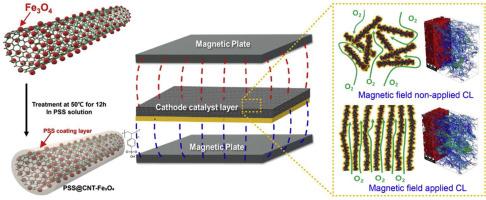Magnetic field aligned carbon nanotube networks for structurally optimized cathodes catalyst layer of polymer electrolyte membrane fuel cells
IF 7.1
Q1 ENGINEERING, CHEMICAL
引用次数: 0
Abstract
The oxygen diffusion resistance and inefficient water removal in conventional cathode catalyst layers (CLs) in polymer electrolyte membrane fuel cells (PEMFCs) restrict their performance at high current densities despite the presence of large pores in the cathode CL. To resolve these issues, a polystyrene sulfonate (PSS)-coated CNT-Fe3O4 (PSS@CNT-Fe3O4) was introduced for preventing agglomeration and facilitating precise pore control under a magnetic field. This study investigated the effect of the orientation of the magnetic field on the drying position of PSS@CNT-Fe3O4 and its impact on the performance of the cathode CL. A CL dried under a bidirectional magnetic field applied from both the top and bottom achieved the highest performance in the high current density region (2.0 A cm–2 at 0.4 V). This improvement was attributed to the continuous distribution of pores in the cathode CL, with no ionomer imbalance. In contrast, the ionomer and catalyst became unevenly distributed when the CL was dried with a magnetic field applied from just one direction (either top or bottom), thereby resulting in reduced performance: 1.54 A cm–2 at 0.4 V (bottom) and 1.87 A cm–2 at 0.4 V (top). These findings suggest the potential of the proposed approach for enhancing the mass transport efficiency of cathode CLs for PEMFCs.

聚合物电解质膜燃料电池阴极催化剂层磁场定向碳纳米管网络结构优化
聚合物电解质膜燃料电池(pemfc)中传统阴极催化剂层(CLs)的氧扩散阻力和低效率的脱水限制了其在高电流密度下的性能,尽管阴极催化剂层上存在较大的孔隙。为了解决这些问题,引入了聚苯乙烯磺酸盐(PSS)包覆的CNT-Fe3O4 (PSS@CNT-Fe3O4),以防止团聚并促进磁场下的精确孔控制。本研究考察了磁场方向对PSS@CNT-Fe3O4干燥位置的影响及其对阴极CL性能的影响。在上下双向磁场作用下干燥的CL在高电流密度区域(0.4 V时2.0 A cm-2)具有最高的性能。这种改善是由于阴极CL中孔隙的连续分布,没有离子不平衡。相反,当仅从一个方向(顶部或底部)施加磁场干燥CL时,离聚体和催化剂分布不均匀,从而导致性能降低:在0.4 V(底部)下1.54 a cm-2,在0.4 V(顶部)下1.87 a cm-2。这些发现表明,所提出的方法有潜力提高阴极cl用于pemfc的质量传输效率。
本文章由计算机程序翻译,如有差异,请以英文原文为准。
求助全文
约1分钟内获得全文
求助全文
来源期刊

Chemical Engineering Journal Advances
Engineering-Industrial and Manufacturing Engineering
CiteScore
8.30
自引率
0.00%
发文量
213
审稿时长
26 days
 求助内容:
求助内容: 应助结果提醒方式:
应助结果提醒方式:


